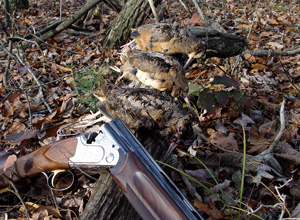
 Among the many joys of hunting upland birds is the chance, necessity really, to seek out new covers. While it's admittedly special to revisit old spots — ones well-seasoned with memories of past autumn days — uncovering the potential of new places has a special value.
Among the many joys of hunting upland birds is the chance, necessity really, to seek out new covers. While it's admittedly special to revisit old spots — ones well-seasoned with memories of past autumn days — uncovering the potential of new places has a special value.
In time, covers outgrow their usefulness to woodcock, becoming too tall and open to provide the necessary ingredients of food and cover. While changes in land use can reduce a hunter's list of spots, more often it's a case of where the place simply outgrew its usefulness. For the woodcock hunter the search to find new places is a perpetual one.
Last week, after spending the first part of the afternoon bumping a few grouse within a familiar cover, my partner and I found ourselves back in the truck, pondering where to try next. There were a couple nearby grousy options. Then I thought of an alder flat, the edge of which is just barely visible from the township road. I'd driven past it many times in the past — considering its potential to hold woodcock — but had never gotten beyond the ponder phase.
With enthusiasm fueled by the start of a few season — and that of a prospective woodcock cover — we circled the edge of a cattail bog. A thick carpet of moss covered the forest floor. I sank in past the top of my left boot, struggling against a vacuum of mud to get out before a flood of muck flowed down to my toes.
We reached the stand of alders, the start of a several-acre of jungle that bordered the headwaters of a small creek. Standing water surrounded moisture-loving trees; hummocks of slightly drier ground were randomly scattered about.
Spreading out about 30 yards we began working the cover. The barbed thorns of a rose bush tested the integrity of my brush pants while another ripped my lip and ear. Why hadn't I tried this earlier, I thought?
A half hour or so into the adventure enthusiasm was being replaced with doubt. Then a flicker near the base of an alder cluster transformed into the whistling flush of a woodcock.
During the next hour we put up several more timberdoodles. We exited the cover through a hedge of briars near the intersection of two seldom used backcountry roads. No bird sniffing dog accompanied us this day, leading to wonder how many more had sat tight and simply let us pass. And we'd only touched a portion of the woodcock habitat before diminishing daylight and energy signaled the end.
Woodcock and grouse covers need identities, monikers understood only by the hunters that name them. Walking back to the truck in a reflective mood, with the setting sun to our backs, I recalled how author Frank Woolner, a well-published writer from New England, often generally referred to woodcock covers as "hot corners." Such as, "Try to park your vehicle in an inconspicuous place, so as to not give away the location of a hot corner."
That evening, in my field journal, with freshly scratched hands I happily recorded the events that took place in a spot now known as the hot corner.
- 3789 views

